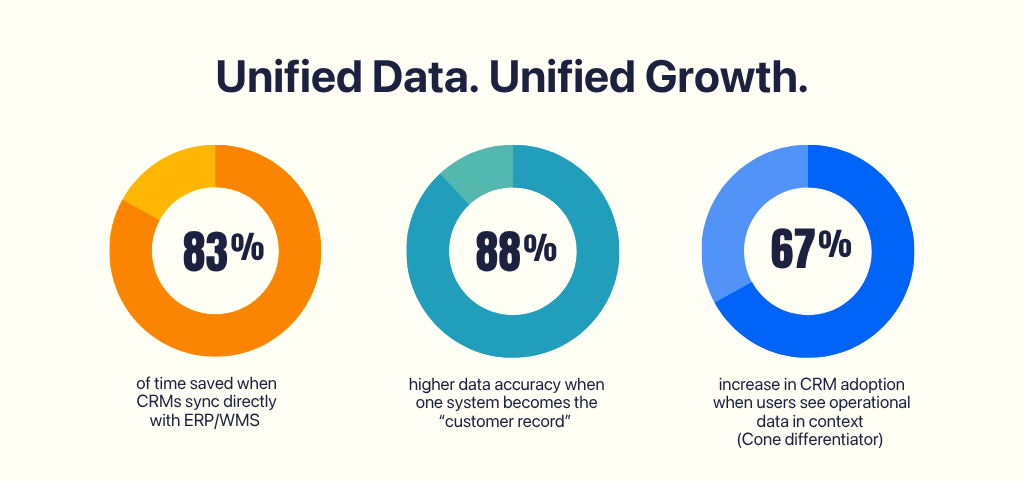How Canadian Wholesale Distributors Can Fix Fragmented Sales Data
If your sales data lives in multiple systems, your team is working harder than it should.
This post explains how Canadian wholesale distributors and logistics companies can fix fragmented sales data through sales process standardization, CRM–ERP integration, and better adoption practices so every department operates from one source of truth.
The Fragmentation Problem You Can’t See
Every distributor knows this story: a rep updates pricing in Excel, operations updates it in the ERP, and finance quotes a different number altogether.
The result? Lost time, frustrated customers, and a management team that doesn’t trust its own dashboards.
This invisible friction, known as data fragmentation, is one of the biggest profit drains in Canadian distribution today.
Fragmentation is not about lacking tools. It is about misalignment between systems, processes, and people.
When your CRM, ERP, and logistics platforms do not communicate, your company runs in silos. Those silos get expensive fast.

The Root Causes of Fragmented Sales Data
Data fragmentation doesn’t happen overnight. It creeps in quietly as your business grows.
Common causes include:
- Legacy systems that cannot integrate with modern CRMs.
- Department silos where sales, logistics, and finance each manage their own data.
- Lack of sales process standardization, so every rep records deals differently.
- Low technology adoption because users avoid clunky, non-intuitive tools.
- Compliance complexity under PIPEDA and Law 25, forcing data to remain isolated.
Each manual export and “temporary fix” compounds the problem. By the time it shows up as inconsistent pricing, delayed orders, or inaccurate reports, the damage is already done.
The Ripple Effects Across the Business
Fragmentation may look like a data problem, but it undermines every function in the company.
- Sales slowdowns
Reps waste hours searching, rekeying, or validating data instead of selling.
- Forecasting blind spots
When CRM and ERP data do not match, forecasting becomes guesswork.
- Customer frustration
Buyers expect instant answers. Disconnected systems create delays that erode trust.
- Compliance risk
Canadian data laws require accuracy and traceability. Siloed systems make compliance audits painful or impossible.
The bottom line is that fragmentation is not just an IT issue. It is a customer experience issue.

The Case for Connected Data
When systems align, people align too.
A connected CRM ecosystem gives sales, operations, logistics, and finance the same real-time view of every customer. That is the foundation of digital transformation that drives actual adoption and measurable ROI.
Companies that integrate CRM, ERP, and warehouse data see major improvements:
- 83 % less time spent on manual data entry.
- 88 % higher data accuracy.
- 67 % higher CRM adoption when users can see operational data in real time.
Unified data eliminates friction. Reps see value in the CRM, leaders gain confidence in their decisions, and customers experience faster, more consistent service.

How to Fix Fragmented Sales Data
You don’t need a massive tech overhaul. You need a plan that connects people, process, and technology.
- Standardize your sales process
Define consistent stages, naming conventions, and data fields so forecasting becomes reliable.
- Integrate your systems
Sync CRM, ERP, and WMS data automatically to remove double entry.
- Automate routine admin work
Use automation for follow-ups, reorders, and pricing updates so reps can focus on customers.
- Centralize visibility
Combine operational and sales dashboards so everyone makes decisions from the same data.
- Focus on adoption
Choose a CRM that is intuitive, mobile-friendly, and designed for right-brain sales users who need simplicity and speed.
Together, these five steps replace fragmented workflows with strategic alignment.
Why the Canadian Context Matters
Canada’s distributors operate in a complex environment that global CRMs rarely address.
- Regulatory compliance under PIPEDA and Law 25 demands transparent data handling.
- Bilingual operations require dual-language interfaces and support.
- Regional logistics require one platform that manages multiple locations without losing visibility.
That is why you need a partner, not just a vendor.
A partner understands local compliance, data residency, and how Canadian distributors actually work. Cone CRM was built for this exact context.
Fixing Fragmentation Is a Leadership Move
Fragmentation is not a technical issue. It is a leadership challenge.
Data visibility equals business visibility, and the leaders who unify systems will outperform those who chase point solutions.
You don’t need to replace everything. Start by connecting what you already have. One source of truth transforms data chaos into operational clarity.
Fixing fragmentation is how modern Canadian distributors reclaim control of their growth.
FAQs
1. What causes fragmented sales data in Canadian distribution?
Disconnected systems. Manual rekeying between CRM, ERP, and warehouse tools creates errors, lost time, and inconsistent reporting.
2. How does CRM integration improve profitability?
Integration reduces duplication, speeds order approvals, and delivers real-time visibility that protects gross margin.
3. Why does CRM adoption fail?



%20A%20CRM%20Tale%20of%20Data%2C%20Drama%2C%20and%20Duct%20Tape%20Privacy.png)



.png)